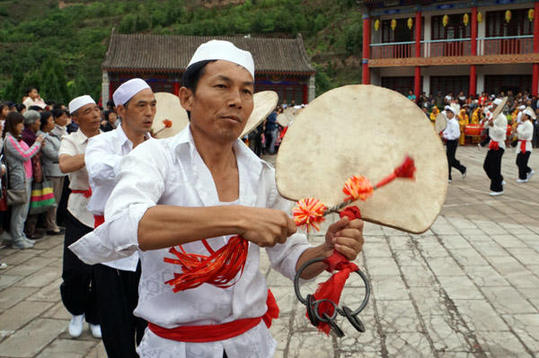Local
Wushan holds Buddhist blessing festival to promote tourism
Updated: 2016-06-30By Li Xiaoxu ( chinadaily.com.cn )
 |
|
Locals perform a land boat dance to mark the opening of a culture and tourism festival in Tianshui city, Wushan county, Gansu province on June 23. [Photo/Xinhua] |
A Buddhist blessing festival was held in Tianshui city, Wushan county in Gansu province from June 23 to 25, attracting more than 30,000 visitors per day. The event was organized to publicize local tourism, said the local authority.
The three-day event, officially titled "Cliff Temple Buddha Blessing, Culture Tourism Festival", gathered locals who gave a traditional drumming performance in the city's Water Curtain Cave square, also known as Shuiliandong square.
Other fun activities included folk performances, concerts, a land boat parade, calligraphy, and a pottery exhibition.
This year, Wushan was awarded as one of China's first national global demonstration zones, due to the county's considerable wealth in natural scenic sites and Buddhist heritage.
 |
|
Locals put on a drum performance in Water Curtain Cave square, or Shuiliandong square, in Tianshui city on June 23. [Photo/Xinhua] |
According to the local authority, the county will try to attract more investment to its tourism industry, and obtain a greater reach to promote its natural beauty and culture to the rest of the world.
Wushan is especially famous for its Water Curtain Cave, a national 4A-level scenic spot.
The Water Curtain Cave is a naturally-occurring grottoe 50 meters tall and 20 meters deep. During the rainy season, water flows over an entrance to the cave creating an effect similar to an old jade curtain.
The Buddhist frescoes found inside the grottoes in Wushan county were made during the Five Dynasties and Ten Kingdoms (AD 907-960). Taking years to construct, the sites are now home to several famous tourist attractions such as the Thousand-Buddha Cave and Lashao Temple which is treasured for its valuable inscriptions, sculpture and frescoes.
The scenic area is home to more than 100 Buddha sculptures, 2,000-square-meters of frescoes, eight dagobas and 10 inscriptions, especially, the Shaola Temple Buddha, the largest outdoor sculpture of a Buddha in Asia.
According to local authorities, due to the increased promotion Wushan county’s natural wonders and Buddhist relics in recent years, social welfare has improved in many areas.
Edited by Owen Fishwick


